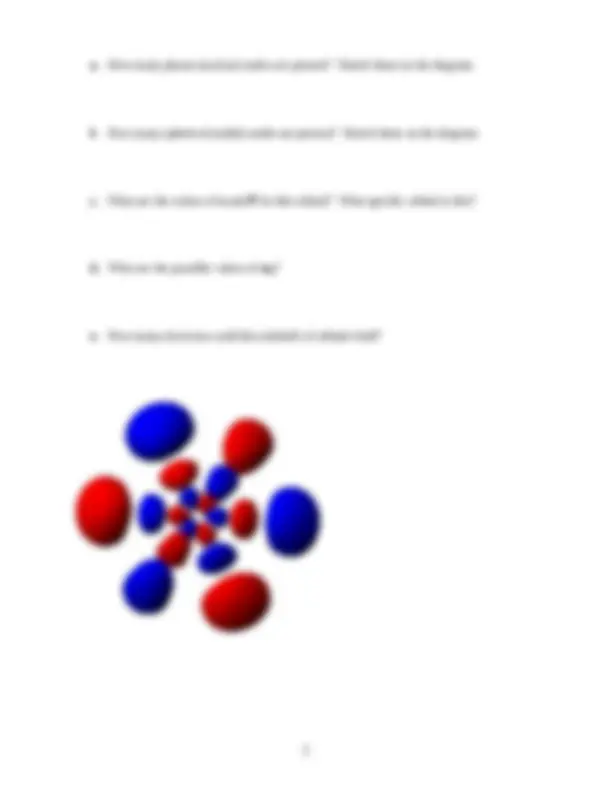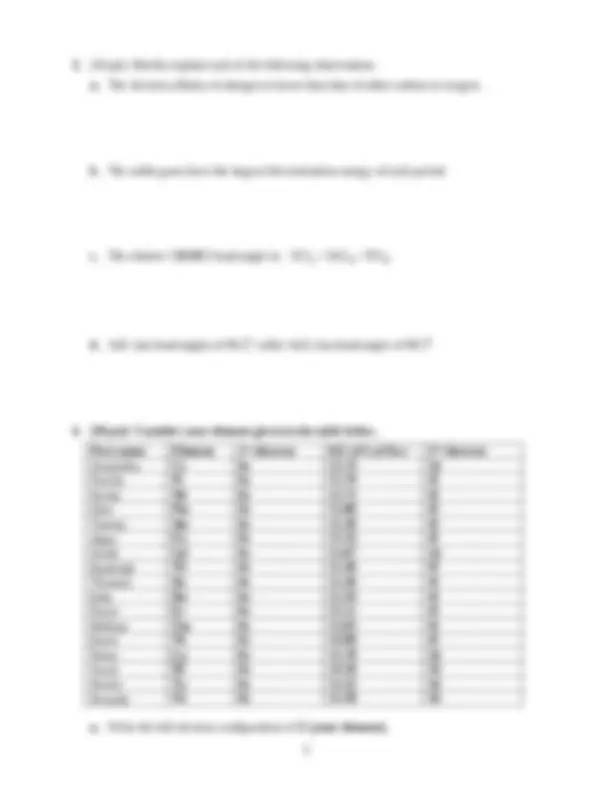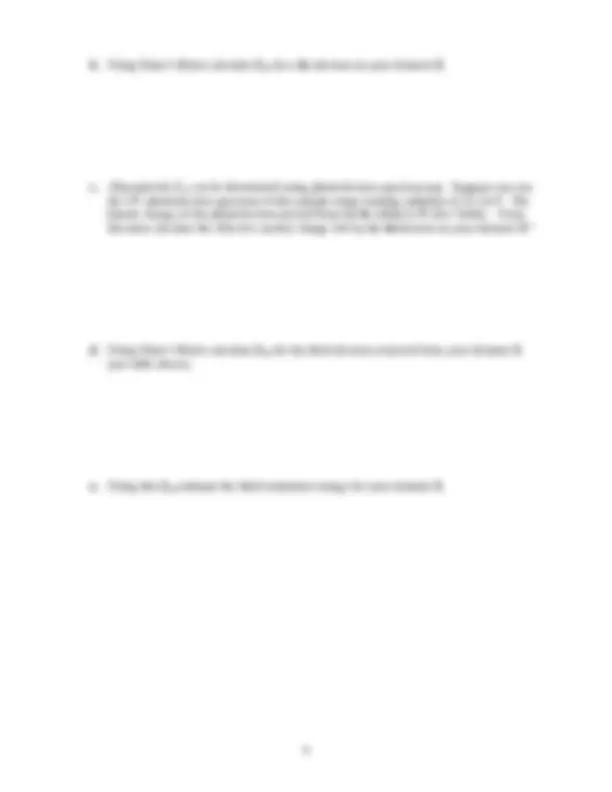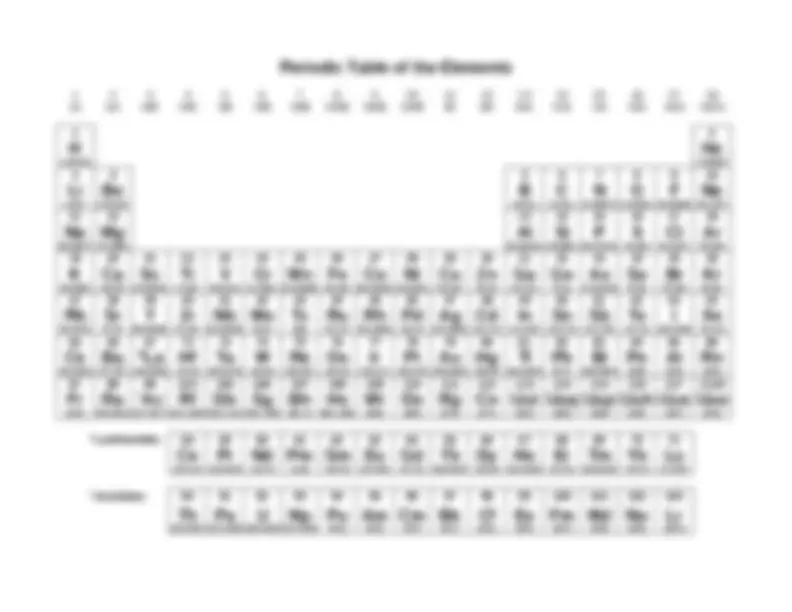






Study with the several resources on Docsity

Earn points by helping other students or get them with a premium plan


Prepare for your exams
Study with the several resources on Docsity

Earn points to download
Earn points by helping other students or get them with a premium plan
Community
Ask the community for help and clear up your study doubts
Discover the best universities in your country according to Docsity users
Free resources
Download our free guides on studying techniques, anxiety management strategies, and thesis advice from Docsity tutors
Material Type: Exam; Professor: Megehee; Class: ADVANCED INORGANIC CHEMISTRY; Subject: CHEMISTRY; University: St. John's University-New York; Term: Fall 2011;
Typology: Exams
1 / 8

This page cannot be seen from the preview
Don't miss anything!





Directions: Please read exam through before beginning. Answer all questions and show all scratch work on this paper. If you have any questions, ASK!! Good Luck.
1 eV = 1.602176462 x 10^19 J = 96.485 kJ/mol = 8065.54477 cm^1 1 u (atomic mass unit) = 1.66053873 x 10^27 kg = 931.494013 MeV
hc R = 1.0973732 x 10^7 m^1 = 1.0973732 x 10^5 cm^1 = Rydberg constnat 4 h x p 2 2 n R Z E eff 2 2
.. n R Z I E eff (^) hc E mv h
2 2 2 1
hc n n
2 2 2 1 2 1 1 n n E Z R 2 2 s kg m J kt N N oe 1 1 2 0693 (^12) k . k ln t ln N = ln No – kt Zeff Z or Zeff Z S A = kN EX-ray = Eorbital + KEe E = h = c
1. [30 pt] Write the balanced nuclear equation for each of the following. a. Predict the most probable mode of spontaneous decay for each of the nuclides below. (^257100) Fm (^14963) Eu Mg 28 12 b. How much energy (in MeV) is released in the nuclear reaction below? Isotopic masses are 152 Gd (151.9205 u), (^42) He (4.00260 u), and 148 Sm (147.9146 u). (^15264) Gd (^14862) Sm (^42) He c. Copper acetate containing 64 Cu is used to study brain tumors. This isotope has a half-life of 12.7 h. If you begin with 25.0 g of 64 Cu, what mass in micrograms remains after 64 h? 2. [15 pt] Consider the orbital shown below:
3. [16 pts] Briefly explain each of the following observations. a. The electron affinity of nitrogen is lower than that of either carbon or oxygen. b. The noble gases have the largest first ionization energy of each period. c. The relative ClMCl bond angle in: SCl 2 > SiCl 4 > PCl 3. d. AsF 3 has bond angles of 96.2, while AsCl 3 has bond angle of 98.5. 4. [28 pts] Consider your element given in the table below. First name Element 1 st^ electron KE (eV) of 6s e‒^3 rd^ electron Dominika Ce 6s 15.74 5d Partha Pr 6s 15.79 4f Rocky Nd 6s 15.72 4f Qiao Pm 6s 15.66 4f Timmy Sm 6s 15.58 4f Alger Eu 6s 15.54 4f Sarah Gd 6s 15.07 5d Kayleigh Tb^ 6s^ 15.36^ 4f Thomas Dy 6s 15.28 4f John Ho^ 6s^ 15.19^ 4f Oscar Er 6s 15.11 4f Melissa Tm 6s 15.03 4f Jessie Yb 6s 14.96 4f Brian Lu 6s 15.78 5d Vivek Hf 6s 14.56 5d Bessie Ta 6s 13.32 5d Hemaly Os^ 6s^ 12.50^ 5d a. Write the full electron configuration of X (your element).
b. Using Slater’s Rules calculate Zeff for a 6 s electron on your element X. c. Alternatively Zeff can be determined using photoelectron spectroscopy. Suppose you ran the UV photoelectron spectrum of this sample using ionizing radiation of 21.21 eV. The kinetic energy of the photoelectron ejected from the 6s orbital is Y (See Table). From this data calculate the effective nuclear charge felt by the 6s electron on your element X? d. Using Slater’s Rules calculate Zeff for the third electron removed from your element X (see table above). e. Using this Zeff estimate the third ionization energy for your element X.
6. [24 pts] Consider the heteronuclear diatomic molecular ion NF a. Draw the best possible Lewis structure for the diatomic NF molecule. b. Which of the atomic orbitals corresponds to the free nitrogen atom and which to the free fluorine atom? Label the diagram. c. What property of the atoms determines this ordering? d. Prepare a molecular orbital diagram for NF , showing clearly how the atomic orbitals interact to form MO’s. [You should give the correct ordering of the MO’s. The spacing does not have to be exact.] Is this a case for sp mixing or not? Be sure to label and number you MO’s properly. e. Place the appropriate number of electrons in each atomic and molecular orbital. How many unpaired spins does NF have? f. Based on your MO diagram and the Lewis structure drawn above, label the orbitals in you diagram as bonding, nonbonding, or antibonding. g. What is the bond order for this molecule based on your diagram?
1 2 3 4 5 6 7 8 9 10 11 12 13 14 15 16 17 18 IA IIA IIIB IVB VB VIB VIIB VIIIB VIIIB VIIIB IB IIB IIIA IVA VA VIA VIIA VIIIA 1 2
1.00794 4. 3 4 5 6 7 8 9 10
6.941 9.01218 10.811 12.011 14.00674 15.9994 18.99840 20. 11 12 13 14 15 16 17 18
22.98977 24.3050 26.98154 28.0855 30.97376 32.066 35.4527 39. 19 20 21 22 23 24 25 26 27 28 29 30 31 32 33 34 35 36
39.0983 40.078 44.95591 47.867 50.9415 51.9961 54.93805 55.845 58.93320 58.6934 63.546 65.39 69.723 72.61 74.92159 78.96 79.904 83. 37 38 39 40 41 42 43 44 45 46 47 48 49 50 51 52 53 54
85.4678 87.62 88.90585 91.224 92.90638 95.94 (98) 101.07 102.9055 106.42 107.8682 112.411 114.818 118.710 121.760 127.60 126.9045 131. 55 56 57 72 73 74 75 76 77 78 79 80 81 82 83 84 85 86
132.9054 137.327 138.9055 178.49 180.9479 183.84 186.207 190.23 192.217 195.078 196.9666 200.59 204.3833 207.2 208.9804 (209) (210) (222) 87 88 89 104 105 106 107 108 109 110 111 112 113 114 115 116 117 1118
†
(223) 226.0254 227.0277 261.1089 262.1144 263.1186 262.12 265.1306 (268) (269) (272) (277) (284) (289) (288) (293) (297) (294)
140.116 140.9076 144.24 (144) 150.36 151.965 157.25 158.9253 162.50 164.9303 167.26 168.9342 173.04 174. † (^) Actinides 90 91 92 93 94 95 96 97 98 99 100 101 102 103
232.0381 231.0358 238.0289 237.0482 (244) (243) (247) (247) (251) (252) (257) (258) (259) (26O)